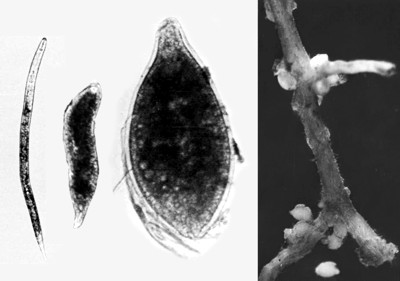Pests
Heterodera medicaginis Kirjanova - Alfalfa Cyst Nematode
Systematic position.
Phylum Nematoda, class Secernentea, order Tylenchida, suborder Hoplolaimina, superfamily Hoplolaimoidea, family Heteroderidae, genus Heterodera.Biological group.
Obligate parasite.Morphology and biology.
Female is lemon-shaped, white, with body length 0.369-1.180 mm and body width 0.180-0.936 mm. Male is vermiform (1.210-1.420 x 0.051-0.067 mm). Eggs are reniform (0.095-0.120 x 0.043-0.050 mm), producing vermiform larvae of I and II instars (0.425-0.496 x 0.0265-0.0298 mm). Parasitic larvae of III instar are bottle-like; those of IV instar are lemon-shaped. Biological cycle takes place in roots of plant hosts, such as Medicago eusativo, M.falcata and M.lupulina. In spring (+6°C), the larvae of II instar move to wet soil down to 30 cm, searching for and invading roots of plant hosts. In roots they become sedentary, feeding and developing into III and IV instars. The late larvae break off the root cortex by their swollen bodies, developing into males or females. The males are mobile; they penetrate through the ruptures into soil, inseminating the females who project their hind end out of the rupture. The female head end remains in the root, where the female continues to feed and produce eggs. The number of eggs (30-550) depends on the food supply. All the eggs remain in the female body, and after the female dies, she becomes a brown cyst with hard external cover. Cysts of the nematode fall from the roots into the soil. Within the cysts, the larvae of II instar develop in eggs; some of them penetrate into soil, and the developmental cycle repeats. The Alfalfa Cyst Nematode has two generations per season. Most of larvae pass anabiosis within the cysts. They remain for several years under unfavorable conditions (wintering, draught, absence of plant hosts). Cysts are spread in field by tillage instruments, water, wind, and contaminated seeds.Distribution.
H. medicaginis was first found in 1968 in Krasnodar Territory (Terent'yeva, Alpat'yev, 1972). In 1980s, its wide distribution and harmfulness were reported in Rostov Region, Krasnodar and Stavropol Territories. This pest prefers areas of unstable humidification and arid steppes where soils have good porosity and no salinity. H. medicaginis is not registered in other regions of alfalfa growing in Russia. In neighboring countries of the Former Soviet Union, the nematode is found in Ukrainian regions adjacent to the North Caucasus and in Uzbekistan. H. medicaginis is not found in other countries.Ecology.
Such spring abiotic conditions as the moderate humidity and light texture of soil are important for movement of the invasive larvae to roots. The nematode development in the roots is ensured by the optimal conditions of alfalfa growth. The increased soil humidity and heavy chernozem soils in submontane zones restrict the H.medicaginis distribution, harmfulness, and accumulation in the soil. At present the ecological factors enabling the Alfalfa Cyst Nematode distribution and accumulation are revealed in the North Caucasus only.Economic significance.
The harmfulness of H.medicaginis consists in the yield decrease of alfalfa herbage and seeds. The main criterion of losses is the extent of soil contamination in spring; i.e., the number of larvae in 100 cubic cm of soil (population density). The agronomical technique also influences the nematode harmfulness; e.g., the time of sowing (spring or summer), undercover or coverless sowing, wide-row or dense sowing, the year of crop growing and its purpose (for forage or for seeds). Accordingly, the 5-10% thresholds of harmfulness are established at the numbers of 330 to 890 larvae per 100 cubic cm. Control measures preventing yield losses include the use of crop rotations with sainfoin and brome as cover crop and sowing of tolerant varieties such as cultivars 'Kubanskaya Zheltaya' and 'Veselopodolyanskaya'.Reference citations:
Artokhina V.G. 1989. The harmfulness of alfalfa cyst nematode in the conditions of lower reach of Don and the ways of its lowering. PhD Thesis. Leningrad-Pushkin: VIZR. 17 p. (in Russian).Dzhunusov K.K. 1985. Alfalfa cyst nematode Heterodera medicaginis Kirjanova, 1971 in the steppe zone of the North Caucasus and the biological basis for the methods of its control. PhD Thesis. Leningrad-Pushkin: VIZR. 19 p. (in Russian).
Kir'yanova E.S., Krall' E.L. 1971. Parasitic plant nematodes and their control. V.2. Leningrad: Nauka. 405 p. (in Russian).
Polyakov I.Ya., Terent'yeva T.G., Gus'kova L.A., Antonova V.V. 1979. Distribution of nematodes - parasites of agricultural crops in the USSR. Moscow: VASKhNIL. 32 p. (in Russian).
Terent'yeva T.G., Alpat'yev N.M. 1972. Alfalfa disease caused by Heterodera medicaginis in the North Caucasus. In: Sveshnikova N.M., ed. Nematode diseases of agricultural crops and their control. Proc. conf. Moscow: VASKhNIL. 55-56 p. (in Russian).
Terentyeva T.G., Gus'kova L.A., Dzhunusov K.K., Alpatyev N.M. 1980. Methodical recommendations for the survey of alfalfa fields to the infestation of alfalfa cyst nematode. Leningrad-Pushkin: VIZR. 13 p. (in Russian).


